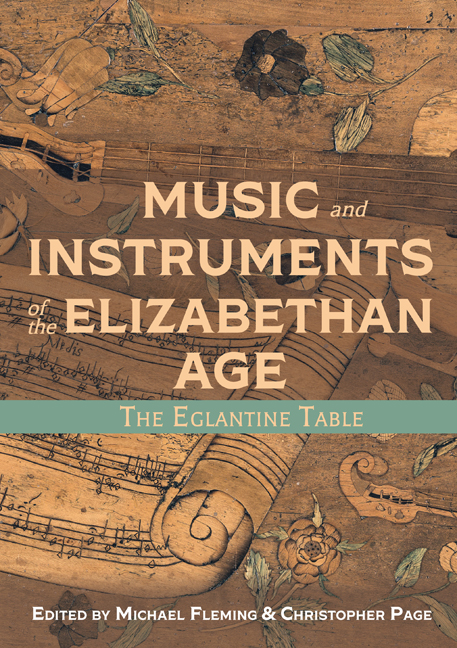Book contents
- Frontmatter
- Dedication
- Contents
- List of Illustrations
- Foreword
- Acknowledgements
- Note to the Reader
- List of Abbreviations
- Introducing the Eglantine Table
- Part I Silent Things
- Part II Music and Instruments
- Part III Broader Views of the Eglantine Table
- Appendices
- Glossary
- Bibliography
- List of Contributors
- Index
- Plate section
10 - The Cittern
Published online by Cambridge University Press: 24 March 2021
- Frontmatter
- Dedication
- Contents
- List of Illustrations
- Foreword
- Acknowledgements
- Note to the Reader
- List of Abbreviations
- Introducing the Eglantine Table
- Part I Silent Things
- Part II Music and Instruments
- Part III Broader Views of the Eglantine Table
- Appendices
- Glossary
- Bibliography
- List of Contributors
- Index
- Plate section
Summary
The Eglantine Table's cittern is the earliest British image of the instrument and was made just before the main period of the cittern's employment by composers around the English court. It is also by far the most accurate depiction.
Citterns were wire-strung musical instruments, smaller than a lute, flat-backed, with a shallow, tapering body, usually played with a plectrum made from the flight feather of a large bird, which is always referred to as a ‘quill’ in contemporary writings. Citterns were made in different sizes. The Table's cittern (Plate 7) is ‘standard-sized’, but a smaller cittern was also common in England. Four or five sizes were possible, and especially in Italy an extended neck could be added, as on lutes. Many Italian citterns had their tuning pegs inserted into a peg-head from above, but most other examples used a pegbox similar to a violin’s. The earliest Italian citterns also had bowed-instrument scrolls but most citterns, again like that on the Table, traditionally carried some kind of finial, usually a carved head, sometimes grotesque which, being ‘brainless’ and ‘wooden’, is used as an insult in Shakespeare's Love's Labours Lost, and less well-known plays by Massinger, Dekker, Jonson and others. The fingerboard had up to nineteen frets, and the resulting frequent changes of position for the left hand were aided by the narrowness of the neck compared with the fingerboard. The neck sat only beneath the treble side of the fingerboard, leaving a space on the bass side in which the thumb could slide up and down easily and accurately. The frets were of brass with a hard wooden ‘wedge’ inserted behind each, and the spaces between frets were gently scalloped.
Superficially most citterns looked similar, but for the player there were some important differences. Firstly, there were two basic tunings, both re-entrant, called by Praetorius ‘French’ and ‘Italian’. The ‘French’ tuning was used in France, Germany and the Low Countries; the ‘Italian’ in Italy and England. French tuning used the notes e′ d′ g a, Italian tuning, e′ d′ g b natural. Both added octave strings on the g course, and French-tuned instruments added them to the a course around 1570.
- Type
- Chapter
- Information
- Music and Instruments of the Elizabethan AgeThe Eglantine Table, pp. 149 - 160Publisher: Boydell & BrewerPrint publication year: 2021

